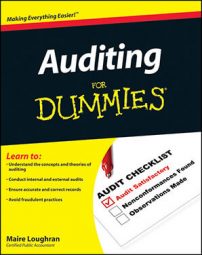While you’re interviewing the audit client, find out about its sources of cash and how often it makes bank deposits. If an audit client — especially a retail client or one receiving a preponderance of customer payments through the mail — has lax controls regarding the frequency of bank depositing, you likely need to perform more sampling and testing of deposited items. Testing deposited items involves questioning management and tracing from the documentary evidence to the accounting record. Tracing means you take evidence of customer sales, such as invoices or cash register Z-tapes, and follow it back to the cash receipts journal.
Don’t forget to consider lapping — when your client has employees divert cash receipts and mask the diversion with subsequent receipts to cover the theft. For example, Joe Smith pays his bill, and the accounting clerk steals the money. The next day, Mary Anderson pays her bill. The accounting clerk applies Anderson’s payment to Smith’s account.
Obtaining information about your client’s bank deposit routines is also important because the nature of the customer deposits indicate their urgency. And the urgency of making deposits will cause you to be more skeptical if a regular deposit day is missed. For example, if your audit client regularly deposits Monday through Friday and you notice that it missed a day, you need to check out the revenue transactions and bank records to see why. Was the missed deposit day a holiday on which either the bank or the client was not open for business? Or is the bank deposit the day after the missed day significantly higher than usual, indicating that two days of deposits are rolled into one?
Most retail clients deposit daily, regardless of whether they have a safe to store the daily cash receipts. The point is not only to limit employee temptation but also to reduce the chance that someone will rob the shop at gunpoint to steal the accumulated cash.
An audit client that receives a high percentage of customer deposits in the form of electronic transfers probably won’t have a regular pattern to its bank runs. That’s because many customer payments are automatically deposited into the company’s checking account. In this case, your assessment of the client’s cash-related internal controls will depend on your assessment of internal controls in other business processes, such as revenue and purchasing.
Companies that often sell and purchase in countries other than the United States likely receive and pay funds electronically. And don’t assume that only large audit clients do business globally.
Cash doesn’t have a very predictable relationship with other financial statement accounts. Therefore, you won’t be using many analytical procedures, which occur when you compare what’s on the books to what you expect to be on the books. However, you may find these two analytical procedures useful:
Comparing balances to prior-period balances: This step is useful when you evaluate imprest accounts. You should discuss any fluctuation with client management.
Checking balances against budgeted figures: Cash budgeted figures include anticipated payments on accounts receivable, cash receipts, and proceeds from debt and equity. If budgeted figures for revenue-based cash receipts don’t reconcile with actual figures, query management and, if necessary, increase your sampling and testing of revenue transactions to see whether any cash receipts were misappropriated.
In addition to these two analytical procedures, you also perform substantive tests of cash balances, including checking out the client’s bank reconciliations and ferreting out kiting.

